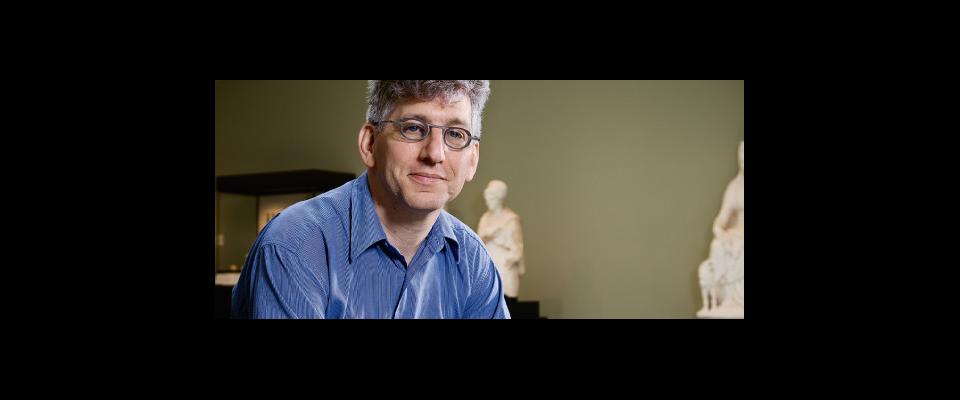From jewelry to disasters, antiquities have much to tell us about ourselves.
“Pompeii is our ground zero for disaster,” Kenneth Lapatin ’84, Ph.D. ’94, says, sitting in LAX airport, waiting for a flight to Paris to gather art for the exhibition Last Days of Pompeii: Decadence, Apocalypse and Resurrection that will open at the Getty Museum in 2012. As we speak, the oil spill in the Gulf of Mexico is making headlines and comparisons to Pompeii are everywhere—just as they were after 9/11, Katrina, the Haiti earthquake. “It’s the obvious comparison. Pompeii lives with us so vividly.”
Few people live with Pompeii quite as vividly as Lapatin, who spends much of his time surrounded by ancient treasure and analyzing the civilizations that produced it—and then looted and forged it. Lapatin is associate curator of antiquities at the J. Paul Getty Museum at the Villa in Malibu, but he spends a lot of time on the road, either examining antiquities or talking about them. Before Paris, he’ll stop in Toledo to lecture on forgeries. Soon after, he’s invited to New York to lecture about ancient gems at a conference for jewelry collectors.
Before coming to the Getty, Lapatin spent eight years as a professor at Boston University, which explains his skill at translating the ancient world for a modern audience. He is most passionate about what he calls “the luxury arts”—carved gems and gold work—and he knows a lot about forgery and repatriation in antiquity. But the subject he is asked to speak about most often is Pompeii.
“When Pompeii was discovered, it was known as the city of the dead. Now it’s considered the city of disaster,” he says. “If you ask me, it’s the perception itself, our changing perceptions of Pompeii, that is perhaps the most important thing about it. Pompeii functions as a mirror of the present.” For example, 19th-century stories of Pompeii were often morality tales suggesting that Pompeii was punished for its sinful ways—similar to Pat Robertson’s “pact to the devil” [sic] comments about Haiti.
That mirror-of-the-present theme runs through Lapatin’s interpretation of forgery, repatriation, and just about everything in the ancient world. “What we want to see of the past is what we find,” he says. “We think of Pompeii as frozen in time. But it’s not. It’s a construct and it’s constantly changing. We’re always asking new questions, and the questions determine the answers we find.”
Lapatin came to Berkeley as an undergraduate intending to study international relations, but he ended up with Alain Renoir for freshman English. Renoir—grandson of the painter, son of the film director, and “a real character”—encouraged Lapatin to study Latin, which led to history, a double major in English and classical languages, then Oxford for classical archaeology. When he left Berkeley with a Ph.D. in 1994, he intended to spend his life as a scholar but found academia too abstract. “As a professor, you’re always talking about the material,” he says, “but you don’t get to handle it.”
Lapatin began working at the Getty in 2002, after helping curate an exhibition there. A few years later, he found himself at the epicenter of Getty’s own disaster. The Italian government was demanding the return of several antiquities, which it claimed were looted. In 2005, Lapatin’s former boss, Marion True, a Getty curator since 1986, was indicted in Italy for conspiracy to traffic in illegal goods. The following year, around the time the Metropolitan Museum of Art agreed to return the Euphronios krater to Italy, the Getty negotiated the return of 37 items. It appears the case against True may finally be dismissed in October, having exceeded the statute of limitations.
It’s an old story, Lapatin says. He prefers not to speak on record about the Getty repatriation specifically, but he is an expert on looting in the ancient world. He can cite 50 examples of things looted in antiquity and later returned. “Repatriation has always been politically motivated,” he says.
When the Romans conquered Carthage in 146 B.C., they returned to the Greeks of Sicily all the loot the Carthaginians had taken. “It was done because it put Rome in a good light, not because it was the right thing to do,” he says. “Whereas now it’s a lot of claims from those who’ve lost the material demanding it back and using various forms of legal arm-twisting.”
Fortunately for the Getty, and for Lapatin, plenty of antiquities remain at the museum. He prefers the small stuff—the carved intaglios, ivories, and intricate gold work of the luxury arts. “I get to hold gems carved for Roman emperors, things once owned and worn by Louis XIV,” he says. “These are intimate objects, meant to be used and manipulated in your hands. As a curator, I get to do this. It’s great fun.”
Lapatin’s job, as he sees it, is to provide the public the same intimate contact, minus the touching. The smaller the object, the more difficult that becomes. “When we think of the Ancient Greek and Roman world, we think of marble statues and figured pots, mainly because that’s what we see. Gems are harder to exhibit but that doesn’t mean we shouldn’t try.”
Last year, with the help of modern technology and the Getty’s considerable resources, he succeeded with Carvers and Collectors using magnification, optic lighting, video demos, and a little retail wisdom: no crowding the cases. “So many exhibitions are put together by curators for curators or scholars, and the result is overkill,” he says. “You don’t want people’s eyes to glaze over. You want them to stop and look and say, ‘I never knew.'”
Roman gold rings with carved intaglios dating to 150 B.C. sell at auction today for less than you’d pay for a designer ring. “Museums aren’t touching the stuff on the market now,” he says. “Small items tend to be not well-documented, so it’s hard to trace their history. We don’t know how much is freshly looted from tombs, and it’s incredibly difficult to ascertain when and where these things were made.”
Forgery, like looting, has been around since civilization began. “Forgeries tell us more about current taste than anything else,” Lapatin says. “In the Renaissance, they forged Roman coins and Roman portraits. In the 18th century, they were forging gems. Between 1909 and 1951, some 9,428 works attributed to Rembrandt entered this country. A huge number have to be fake, but it shows that what people wanted were Old Masters.”
What are they forging today? “Mainly African art, pre-Columbian art, Oceanic art, modern art. That’s where the market is now,” says Lapatin. “When there is a desire for something, businessmen will step in to profit.”





















